

The Luckiest Cat in the World
|
The sight of white cat ornament waving its hand is a common sight throughout Japan, especially at shop entrances. Known as maneki neko (beckoning cat), the paw being raised actually has different significances. A raised right paw beckons wealth, whereas a raised left paw beckons people or customers. Sometimes you may even see them with both paws raised, which signifies protection. It is said that the higher the paw is raised, the more luck is beckons!
Traditionally, a maneki neko is white in colour. However, colourful ones are sold too, each inviting blessings to different fields or even warding off bad luck. For example, pink is for success with love, and green is for academic achievement. On the other hand, red is for warding off illness, and black is for warding off evil. Sometimes the cat figure may even be adorned with accessories such as gold coins used during the Edo period, and other auspicious symbols. For example, the cat may be holding a fan or drum, which are thought to represent luck with business. Or you may see a carp, which is often associated with fortune. How did the maneki neko originate then? One story dating back to 1852 describes that an elderly woman living in Imado was so poor, to the point where she could no longer feed her pet cat and had no choice but to let it go. The cat appeared in her dreams on the same night, and said that she will have good fortune if she sells dolls made in its image. The woman followed its words by making cat ceramic figures using Imado ware, and sold them at the nearby Asakura shrine. True to what it promised, the figures sold well and saved the woman from poverty. Hiroshige Utagawa’s depiction of lucky cat ornaments can be found on his woodblock print that was illustrated 1852, and this is in fact the oldest known image of maneki neko. Another famous story takes place in Gotokuji Temple that is located in Setagaya ward, Tokyo. Legend has it that a feudal lord Naotaka Ii passed by the temple and was beckoned by the abbot’s cat. So he rested inside the temple and in doing so, avoided being struck by a lightning bolt. Grateful to the cat, Naotaka Ii donated a handsome sum of money to the temple, and the auspicious icon maneki neko was born. Today, Gotokuji Temple is filled with dozens of maneki neko of varying sizes. Visitors make offerings at this temple, believing that their wishes can be granted by maneki neko. The Tokyu-Setagaya line that runs past Gotokuji Temple also has a “Lucky Maneki Neko Train” which was unveiled on the 110th anniversary of the line in 2017. The exterior is decorated with motifs of the lucky cat. As for the interior, the hand straps are shaped like the lucky cat, and there are even paw prints dotted across on the floor. You can also find many maneki neko items around the temple, be it a soba shop selling dishes with maneki neko design or stores selling Japanese sweets in the shape of maneki neko. Maneki neko is also prominent in Seto city, Aichi Prefecture, as the city produces an abundance of pottery as well as maneki neko ornaments. In fact, you can find maneki neko hidden all around the city in 29 spots. There is also a museum dedicated to the auspicious symbol, where you can experience painting your own maneki neko. Besides that, the city holds an annual festival called Kuru Fuku Maneki Neko Matsuri (Festival of incoming fortune and maneki neko) where lunches come in boxes shaped as the lucky cat, and participants can paint on maneki neko makeup. For many years, the iconic cat ornament has represented good fortune and luck in Japan. It has also gained popularity across the globe with its widespread appeal, and is often a popular souvenir for tourists. If you wish to invite good luck or chase away bad luck from your home in the new year, perhaps you can consider getting a maneki neko of your own! |
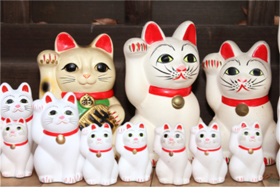 © Web Japan 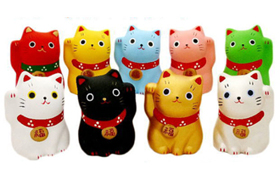 © ORNER KOIDE 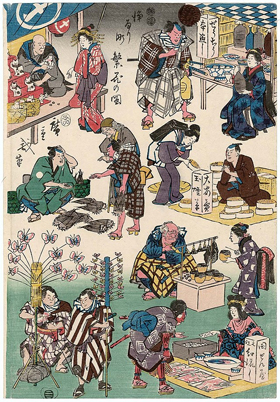 Characters from Plays as Merchants and Customers, “Flourishing Business in Balladtown” (© Hiroshige Utagawa, Public domain, via Wikimedia Commons) 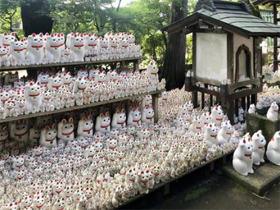 © photoAC 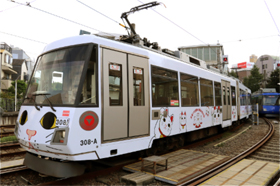 © Tokyu Corporation 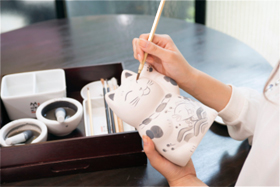 © Seto City Exchange Club |
Resources
|
“Lucky Cats – Maneki Neko”. 2022. Kids Web Japan. Accessed 16 December. https://web-japan.org/kidsweb/cool/18/luckycats_en.html. Saunders, Rebecca. 2021. “The fascinating history behind the popular ‘waving lucky cat’”. National Geographic. https://www.nationalgeographic.com/travel/article/the-fascinating-history-behind-the-popular-waving-lucky-cat. “Maneki Neko: The Lucky Cats of Japan”. 2021. LIVE JAPAN. https://livejapan.com/en/in-tokyo/in-pref-tokyo/in-tokyo_train_station/article-a0000697/. |
|
Japan Creative Centre 4 Nassim Road, Singapore 258372 +65 6737 0434 / jcc@sn.mofa.go.jp https://www.sg.emb-japan.go.jp/JCC/ Nearest parking at Orchard Hotel & Delphi Orchard |
 |